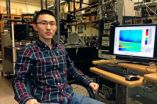(Press-News.org) In physics, there's small, and then there's nullity – as in zero-dimensional.
University of Cincinnati researchers have reached this threshold with a special structure that may someday lead to better ways of harnessing solar energy, stronger lasers or more sensitive medical diagnostic devices.
These structures are semiconductor nanowires. UC doctoral student Teng Shi says she and a team of researchers have observed unique optical signatures indicating that electronic excitations within these nanowires can be confined to a zero-dimensional state called a "quantum dot."
This latest discovery is all about going small, but its significance is anything but. The research team's ability to control the confinement energy by varying the size of the quantum dot opens up a world of possibilities.
"Exploring the basic physics of semiconductor nanowires enables one to envision applications or to design structures for applications," says Shi of UC's Department of Physics. "These structures are potential candidates for a variety of applications including photovoltaics, lasers and ultra-sensitive nanosensors."
Shi will present the team's research "Temperature-dependent Photoluminescence Imaging of GaAs/AlGaAs Heterostructure Quantum Well Tubes" at the American Physical Society (APS) meeting to be held March 3-7 in Denver. Nearly 10,000 professionals, scholars and students will attend the APS meeting to discuss new research from industry, universities and laboratories from around the world.
This research advances work previously done on semiconductor nanowires at UC. By using a thin shell called a quantum well tube and growing it – to about 4 nanometers thick – around the nanowire core, researchers found electrons within the nanowire were distributed in an unusual way in relation to the facets of the hexagonal tube. The result is a quantum wire, like a long string many times thinner than a human hair.
Now they've taken things even further, going from one-dimensional wires to zero-dimensional quantum dots. These little structures could have a big effect on a variety of technologies. Semiconductors are at the center of modern electronics. Computers, TVs and cellphones have them. They're made from the crystalline form of elements that have scientifically beneficial electrical conductivity properties. Many semiconductors are made of silicon, but gallium arsenide is used in this research.
INFORMATION:
Additional contributors to this research are UC physics professors Howard Jackson and Leigh Smith in the McMicken College of Arts and Sciences; Jan Yarrison-Rice of Miami University; and Nian Jiang, Hoe Tan, Qiang Gao and Chennupati Jagadish of Australian National University.
The team at UC is one of only about a half dozen in the U.S. conducting competitive research in the field, and UC's efforts in this area are partially funded by the National Science Foundation. The team's big achievements in the science of small support the UC2019 Academic Master Plan by producing new ways of understanding and transforming the world through research and scholarship.
Physics in 3-D? That's nothing. Try 0-D
Zero-dimensional quantum dots identified by University of Cincinnati researchers could someday have a big effect on a variety of technologies, such as solar energy, lasers and medical diagnostics
2014-03-04
ELSE PRESS RELEASES FROM THIS DATE:
How 19th century physics could change the future of nanotechnology
2014-03-04
A new twist on a very old physics technique could have a profound impact on one of the most buzzed-about aspects of nanoscience.
Researchers at the University of Cincinnati have found that their unique method of light-matter interaction analysis appears to be a good way of helping make better semiconductor nanowires.
"Semiconductor nanowires are one of the hottest topics in the nanoscience research field in the recent decade," says Yuda Wang, a UC doctoral student. "Due to the unique geometry compared to conventional bulk semiconductors, nanowires have already shown ...
Next step in live-donor uterus transplant project
2014-03-04
In Sweden alone, an estimated 2 000 young women of fertile age cannot become pregnant either because they were born without a womb or lost it later due to disease.
Professor Mats Brännström, researcher at the University of Gothenburg and chief physician, is leading a unique research project aiming to make it possible for these women to have a uterus transplant and then get pregnant.
A decade of research
After more than a decade of research that has been evaluated in almost 40 scientific articles, in May 2012 the research team received permission from the Regional Ethical ...
Dramatic drop in US IPO activity can't be blamed on tougher regulations
2014-03-04
Toronto – An extensive study of initial public offerings shows dramatic changes in the IPO landscape around the world over the past two decades, including a large decrease in the importance of IPOs in the United States while IPOs became more important in other countries. This drop in U.S. IPOs cannot be explained by stricter regulations enacted after the corporate and accounting scandals in the early part of the 2000s.
"One of the main things people point fingers at is the Sarbanes Oxley Act. We show that U.S. IPO activity became abnormally low before the Sarbanes Oxley ...
Which interventions are most effective to promote exclusive breastfeeding?
2014-03-04
New Rochelle, NY, March 4, 2014—Only about 37% of babies around the world are exclusively breastfed for the first 6 months of life, as recommended by the World Health Organization (WHO). The benefits of breastfeeding for both infants and mothers are well-established. The effectiveness of different types of interventions for promoting exclusive breastfeeding in high-income countries is the focus of a Review article published in Breastfeeding Medicine, the official journal of the Academy of Breastfeeding Medicine published by Mary Ann Liebert, Inc., publishers. The article ...
Predators delay pest resistance to Bt crops
2014-03-04
ITHACA, N.Y. – Crops genetically modified with the bacterium Bt (Bacillus thuringiensis) produce proteins that kill pest insects. Steady exposure has prompted concern that pests will develop resistance to these proteins, making Bt plants ineffective.
Cornell research shows that the combination of natural enemies, such as ladybeetles, with Bt crops delays a pest's ability to evolve resistance to these insecticidal proteins.
"This is the first demonstrated example of a predator being able to delay the evolution of resistance in an insect pest to a Bt crop," said Anthony ...
Aggression, rule-breaking common among Taiwanese teenagers who have early sex
2014-03-04
Taiwanese teenagers – and especially females – who become sexually active at a very young age are more likely to be rule-breakers and be more aggressive than their peers. These are the findings of a national study of Taiwanese youth led by Wei J. Chen of the National Taiwan University, with Chia-Hua Chan as first author. It is published in Springer's journal Archives of Sexual Behavior.
Nearly 19,000 sixteen- to nineteen-year-old Taiwanese adolescents took part in a national survey which was conducted through a self-administered web-based questionnaire. Sociodemographic ...
Study finds experiences of racism associated with weight gain in African American women
2014-03-04
(Boston)--A recent analysis conducted by investigators from the Slone Epidemiology Center at Boston University has found that frequent experiences of racism were associated with a higher risk of obesity among African American women. The findings, which currently appear online in the American Journal of Epidemiology, found the relationship between racism and obesity was strongest among women who reported consistently high experiences of racism over a 12-year period. The research was based on data from the Black Women's Health Study, a longitudinal study that enrolled 59,000 ...
IOF-IFCC study summarizes fracture prediction strength of reference bone turnover markers
2014-03-04
Nyon, Switzerland – March 4, 2014
A new study by an International Osteoporosis Foundation (IOF) and International Federation of Clinical Chemistry and Laboratory Medicine (IFCC) scientific working group summarizes the clinical performance of serum procollagen type I N propeptide (s-PINP) and serum C-terminal cross-linking telopeptide of type I collagen (s-CTX) in fracture risk prediction in untreated individuals in prospective cohort studies.
The current study follows a position paper published in 2011 by the IOF-IFCC Bone Marker Standards Working Group recommending ...
Fighting against HIV in the Central African Republic -- the importance of perseverance
2014-03-04
According to Pierre-Marie David of the University of Montreal's Faculty of Pharmacy, stock-outs of antiretroviral (ARV) drugs in recent years in the Central African Republic have had a dramatic impact on the health of HIV-infected people. These shortages have also created mistrust among patients toward the political and medical actors responsible for the fight against HIV/AIDS. And their wariness is likely to reduce their chances of getting better. David lived in the Central African Republic from 2005 to 2008, where he worked as Access to Antiretroviral Treatment Coordinator ...
New therapy helps to improve audio and visual perception in stroke patients
2014-03-04
A stroke can cause permanent damage to important parts of the brain, with the result that many stroke survivors require lifelong care and support. 'It is not uncommon for stroke patients to suffer from an awareness deficit or a reduced response to stimuli on one side of their body. This condition, known as hemispatial neglect, can mean that patients are unable to properly perceive people, images or sounds on that side,' explains Professor Georg Kerkhoff from the Department of Clinical Neuropsychology at Saarland University. 'These phenomena tend to be observed when the ...
LAST 30 PRESS RELEASES:
Penn researchers awarded $25M to conduct trial using smartphones to fight heart disease
PCORI awards funding for new patient-centered healthcare research
Exploring the origins of the universe: 145 low-noise amplifiers complete ALMA telescopes
Empress cicada wings help illuminate molecular structure
Using sound waves to detect helium
Time burden in patients with metastatic breast and ovarian cancer from clinic and home demands
Researchers discover bias in AI models that analyze pathology samples
Scientists ID potential way to prevent brain injuries from triggering Alzheimer's
MASTER 2nd Open Call: Execution period kick-off
Algae for health in food and pharma
Advanced microrobots driven by acoustic and magnetic fields for biomedical applications
Chicago health information leader recognized for raising CPR readiness and blood pressure awareness
The Intimate Animal, a new book from Kinsey Institute Executive Director Dr. Justin Garcia
When blue-collar workers lose union protection, they try self-employment
New video dataset to advance AI for health care
MEA-based graph deviation network for early autism syndrome signatures in human forebrain organoids
New modeling approach sheds light on rare gut disease
Study documents potentially hazardous flame retardants in firefighter gear
Can certain bacteria regulate aging of the immune system and its related alterations?
AI model helps diagnose often undetected heart disease from simple EKG
There are fewer online trolls than people think
Cell membrane fluctuations produce electricity
Jeonbuk National University study shows positive parenting can protect adolescents against self-harm
Surface-engineered ZnO nanocrystals to tackle perfluoroalkyl substance contamination
This new understanding of T cell receptors may improve cancer immunotherapies
A new fossil face sheds light on early migrations of ancient human ancestor
A new immunotherapy approach could work for many types of cancer
A new way to diagnose deadly lung infections and save lives
40 percent of MRI signals do not correspond to actual brain activity
How brain-inspired algorithms could drive down AI energy costs
[Press-News.org] Physics in 3-D? That's nothing. Try 0-DZero-dimensional quantum dots identified by University of Cincinnati researchers could someday have a big effect on a variety of technologies, such as solar energy, lasers and medical diagnostics





